NURS2096: Split-Skin Grafting - Preoperative and Postoperative Care
VerifiedAdded on 2023/06/07
|9
|1903
|367
Report
AI Summary
This report outlines the preoperative and postoperative management of a patient undergoing split-skin grafting for a full-thickness burn on the anterior chest wall. Preoperative management focuses on assessment, evaluation, investigation, and patient education, including airway maintenance, edema reduction, and infection prevention. Postoperative management includes immediate care within the first 24 hours, emphasizing pain management, temperature regulation, and fluid balance, as well as long-term care involving wound care, physical therapy, and psychological support. The report also addresses potential postoperative complications such as pain, bleeding, pulmonary edema, delirium, sepsis, and grafting issues, highlighting the importance of multidisciplinary care and detailed planning for optimal patient outcomes. Desklib offers a range of study tools and resources for students.

Preoperative and postoperative
care for split-skin grafting for
anterior chest wall burn injury
care for split-skin grafting for
anterior chest wall burn injury
Secure Best Marks with AI Grader
Need help grading? Try our AI Grader for instant feedback on your assignments.

Contents
Introduction......................................................................................................................................3
Pre-operative management..............................................................................................................3
Post-operative management within 24 hours...................................................................................4
Long-term post-operative management...........................................................................................5
Postoperative complications............................................................................................................6
Conclusion.......................................................................................................................................7
References........................................................................................................................................8
Introduction......................................................................................................................................3
Pre-operative management..............................................................................................................3
Post-operative management within 24 hours...................................................................................4
Long-term post-operative management...........................................................................................5
Postoperative complications............................................................................................................6
Conclusion.......................................................................................................................................7
References........................................................................................................................................8
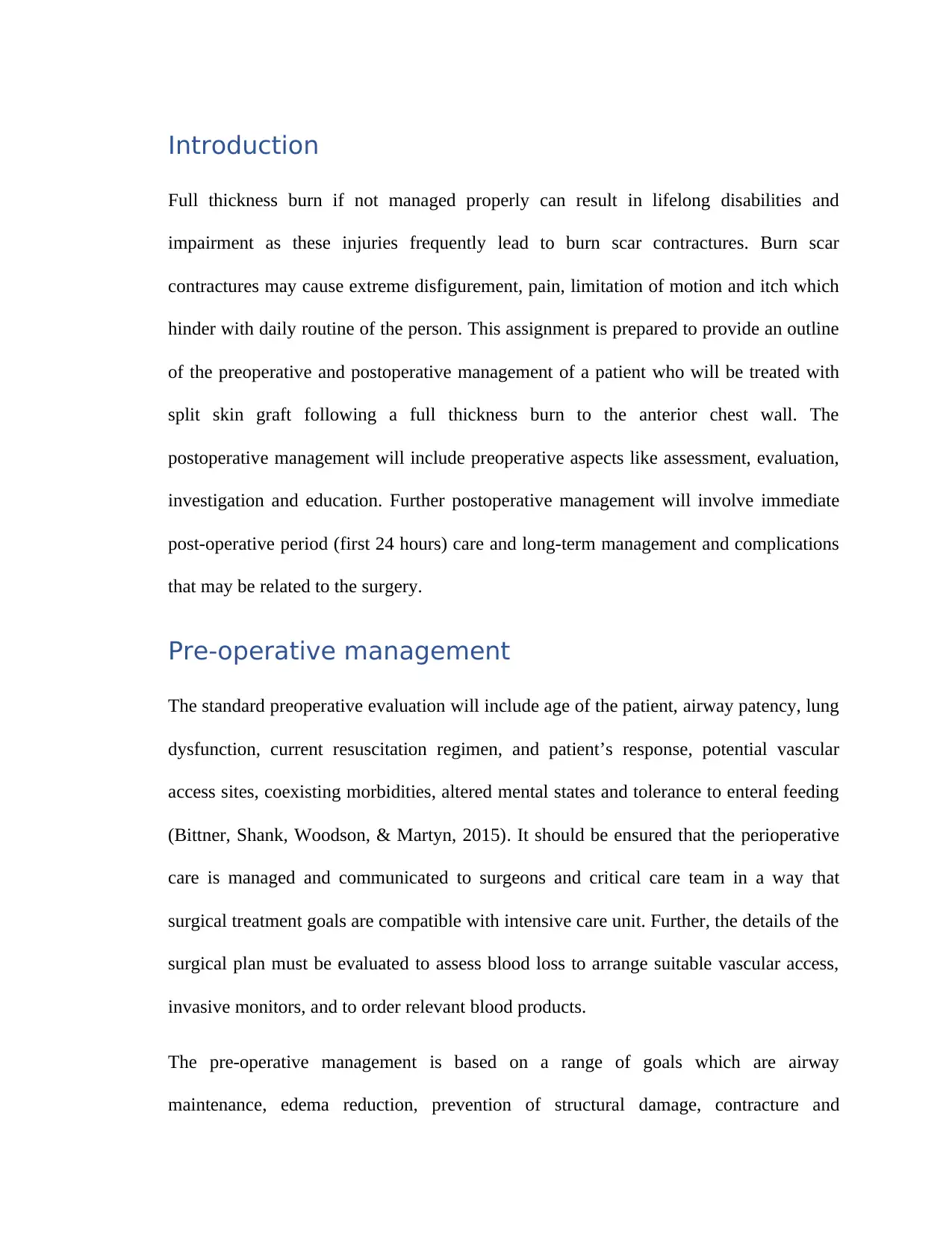
Introduction
Full thickness burn if not managed properly can result in lifelong disabilities and
impairment as these injuries frequently lead to burn scar contractures. Burn scar
contractures may cause extreme disfigurement, pain, limitation of motion and itch which
hinder with daily routine of the person. This assignment is prepared to provide an outline
of the preoperative and postoperative management of a patient who will be treated with
split skin graft following a full thickness burn to the anterior chest wall. The
postoperative management will include preoperative aspects like assessment, evaluation,
investigation and education. Further postoperative management will involve immediate
post-operative period (first 24 hours) care and long-term management and complications
that may be related to the surgery.
Pre-operative management
The standard preoperative evaluation will include age of the patient, airway patency, lung
dysfunction, current resuscitation regimen, and patient’s response, potential vascular
access sites, coexisting morbidities, altered mental states and tolerance to enteral feeding
(Bittner, Shank, Woodson, & Martyn, 2015). It should be ensured that the perioperative
care is managed and communicated to surgeons and critical care team in a way that
surgical treatment goals are compatible with intensive care unit. Further, the details of the
surgical plan must be evaluated to assess blood loss to arrange suitable vascular access,
invasive monitors, and to order relevant blood products.
The pre-operative management is based on a range of goals which are airway
maintenance, edema reduction, prevention of structural damage, contracture and
Full thickness burn if not managed properly can result in lifelong disabilities and
impairment as these injuries frequently lead to burn scar contractures. Burn scar
contractures may cause extreme disfigurement, pain, limitation of motion and itch which
hinder with daily routine of the person. This assignment is prepared to provide an outline
of the preoperative and postoperative management of a patient who will be treated with
split skin graft following a full thickness burn to the anterior chest wall. The
postoperative management will include preoperative aspects like assessment, evaluation,
investigation and education. Further postoperative management will involve immediate
post-operative period (first 24 hours) care and long-term management and complications
that may be related to the surgery.
Pre-operative management
The standard preoperative evaluation will include age of the patient, airway patency, lung
dysfunction, current resuscitation regimen, and patient’s response, potential vascular
access sites, coexisting morbidities, altered mental states and tolerance to enteral feeding
(Bittner, Shank, Woodson, & Martyn, 2015). It should be ensured that the perioperative
care is managed and communicated to surgeons and critical care team in a way that
surgical treatment goals are compatible with intensive care unit. Further, the details of the
surgical plan must be evaluated to assess blood loss to arrange suitable vascular access,
invasive monitors, and to order relevant blood products.
The pre-operative management is based on a range of goals which are airway
maintenance, edema reduction, prevention of structural damage, contracture and
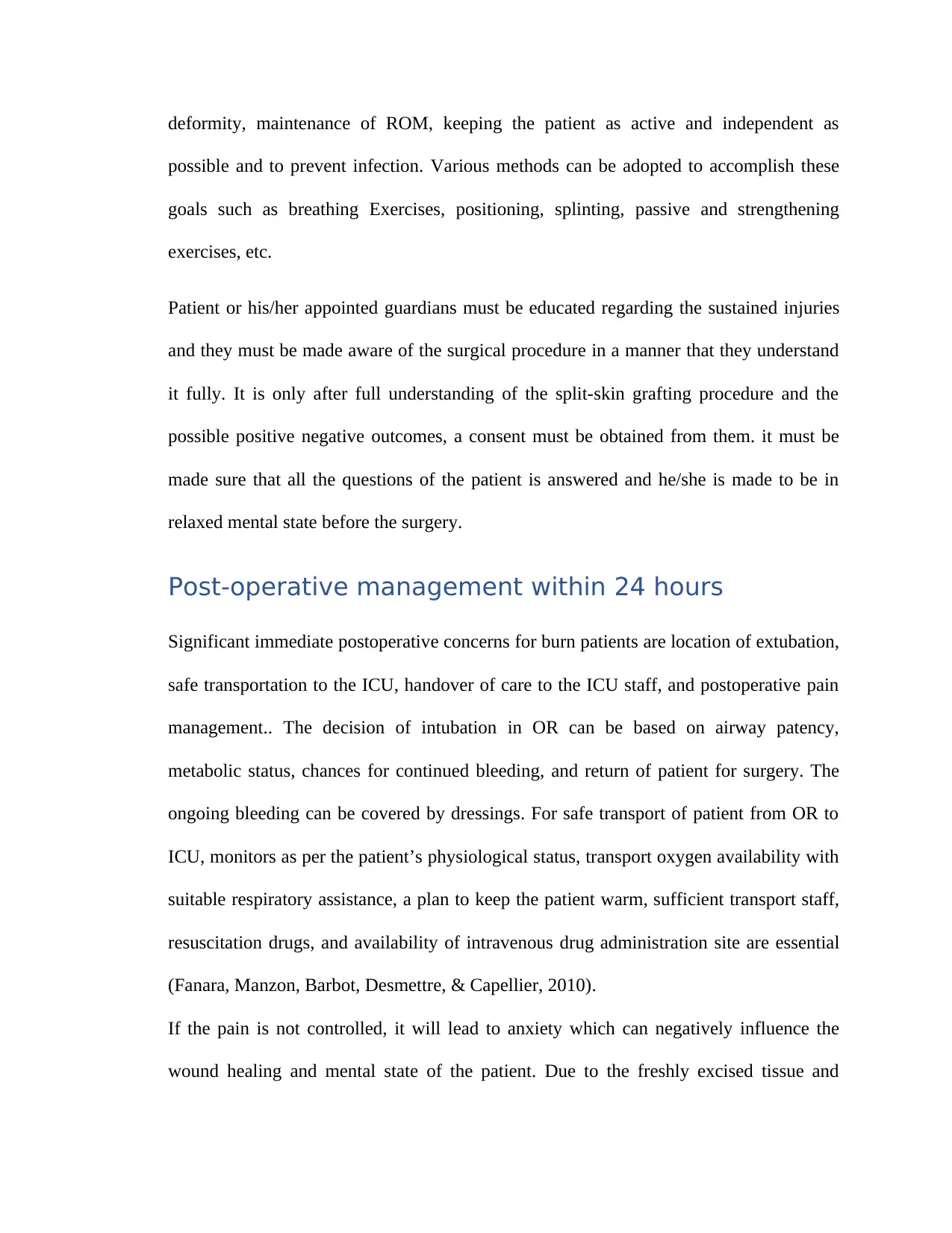
deformity, maintenance of ROM, keeping the patient as active and independent as
possible and to prevent infection. Various methods can be adopted to accomplish these
goals such as breathing Exercises, positioning, splinting, passive and strengthening
exercises, etc.
Patient or his/her appointed guardians must be educated regarding the sustained injuries
and they must be made aware of the surgical procedure in a manner that they understand
it fully. It is only after full understanding of the split-skin grafting procedure and the
possible positive negative outcomes, a consent must be obtained from them. it must be
made sure that all the questions of the patient is answered and he/she is made to be in
relaxed mental state before the surgery.
Post-operative management within 24 hours
Significant immediate postoperative concerns for burn patients are location of extubation,
safe transportation to the ICU, handover of care to the ICU staff, and postoperative pain
management.. The decision of intubation in OR can be based on airway patency,
metabolic status, chances for continued bleeding, and return of patient for surgery. The
ongoing bleeding can be covered by dressings. For safe transport of patient from OR to
ICU, monitors as per the patient’s physiological status, transport oxygen availability with
suitable respiratory assistance, a plan to keep the patient warm, sufficient transport staff,
resuscitation drugs, and availability of intravenous drug administration site are essential
(Fanara, Manzon, Barbot, Desmettre, & Capellier, 2010).
If the pain is not controlled, it will lead to anxiety which can negatively influence the
wound healing and mental state of the patient. Due to the freshly excised tissue and
possible and to prevent infection. Various methods can be adopted to accomplish these
goals such as breathing Exercises, positioning, splinting, passive and strengthening
exercises, etc.
Patient or his/her appointed guardians must be educated regarding the sustained injuries
and they must be made aware of the surgical procedure in a manner that they understand
it fully. It is only after full understanding of the split-skin grafting procedure and the
possible positive negative outcomes, a consent must be obtained from them. it must be
made sure that all the questions of the patient is answered and he/she is made to be in
relaxed mental state before the surgery.
Post-operative management within 24 hours
Significant immediate postoperative concerns for burn patients are location of extubation,
safe transportation to the ICU, handover of care to the ICU staff, and postoperative pain
management.. The decision of intubation in OR can be based on airway patency,
metabolic status, chances for continued bleeding, and return of patient for surgery. The
ongoing bleeding can be covered by dressings. For safe transport of patient from OR to
ICU, monitors as per the patient’s physiological status, transport oxygen availability with
suitable respiratory assistance, a plan to keep the patient warm, sufficient transport staff,
resuscitation drugs, and availability of intravenous drug administration site are essential
(Fanara, Manzon, Barbot, Desmettre, & Capellier, 2010).
If the pain is not controlled, it will lead to anxiety which can negatively influence the
wound healing and mental state of the patient. Due to the freshly excised tissue and
Secure Best Marks with AI Grader
Need help grading? Try our AI Grader for instant feedback on your assignments.
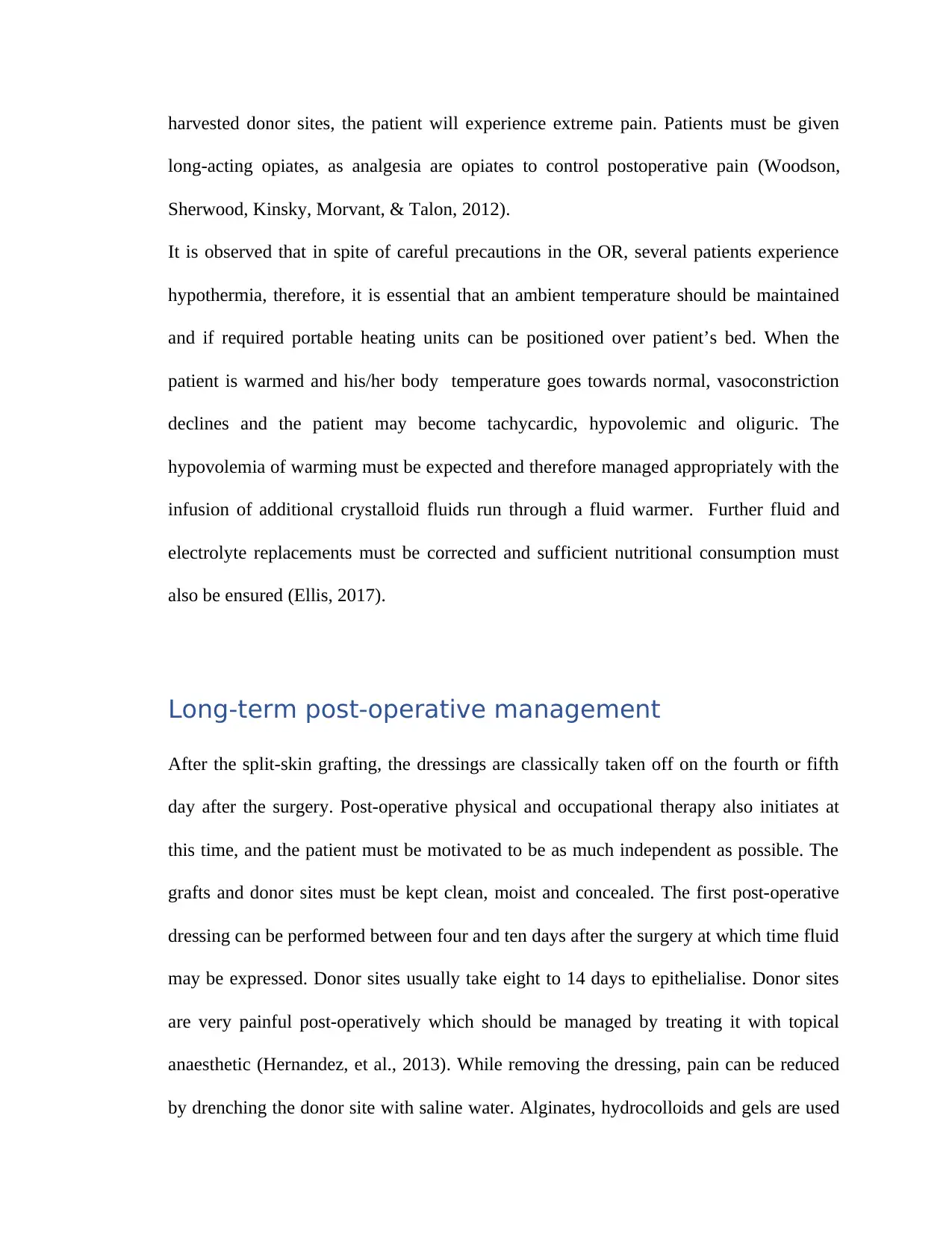
harvested donor sites, the patient will experience extreme pain. Patients must be given
long-acting opiates, as analgesia are opiates to control postoperative pain (Woodson,
Sherwood, Kinsky, Morvant, & Talon, 2012).
It is observed that in spite of careful precautions in the OR, several patients experience
hypothermia, therefore, it is essential that an ambient temperature should be maintained
and if required portable heating units can be positioned over patient’s bed. When the
patient is warmed and his/her body temperature goes towards normal, vasoconstriction
declines and the patient may become tachycardic, hypovolemic and oliguric. The
hypovolemia of warming must be expected and therefore managed appropriately with the
infusion of additional crystalloid fluids run through a fluid warmer. Further fluid and
electrolyte replacements must be corrected and sufficient nutritional consumption must
also be ensured (Ellis, 2017).
Long-term post-operative management
After the split-skin grafting, the dressings are classically taken off on the fourth or fifth
day after the surgery. Post-operative physical and occupational therapy also initiates at
this time, and the patient must be motivated to be as much independent as possible. The
grafts and donor sites must be kept clean, moist and concealed. The first post-operative
dressing can be performed between four and ten days after the surgery at which time fluid
may be expressed. Donor sites usually take eight to 14 days to epithelialise. Donor sites
are very painful post-operatively which should be managed by treating it with topical
anaesthetic (Hernandez, et al., 2013). While removing the dressing, pain can be reduced
by drenching the donor site with saline water. Alginates, hydrocolloids and gels are used
long-acting opiates, as analgesia are opiates to control postoperative pain (Woodson,
Sherwood, Kinsky, Morvant, & Talon, 2012).
It is observed that in spite of careful precautions in the OR, several patients experience
hypothermia, therefore, it is essential that an ambient temperature should be maintained
and if required portable heating units can be positioned over patient’s bed. When the
patient is warmed and his/her body temperature goes towards normal, vasoconstriction
declines and the patient may become tachycardic, hypovolemic and oliguric. The
hypovolemia of warming must be expected and therefore managed appropriately with the
infusion of additional crystalloid fluids run through a fluid warmer. Further fluid and
electrolyte replacements must be corrected and sufficient nutritional consumption must
also be ensured (Ellis, 2017).
Long-term post-operative management
After the split-skin grafting, the dressings are classically taken off on the fourth or fifth
day after the surgery. Post-operative physical and occupational therapy also initiates at
this time, and the patient must be motivated to be as much independent as possible. The
grafts and donor sites must be kept clean, moist and concealed. The first post-operative
dressing can be performed between four and ten days after the surgery at which time fluid
may be expressed. Donor sites usually take eight to 14 days to epithelialise. Donor sites
are very painful post-operatively which should be managed by treating it with topical
anaesthetic (Hernandez, et al., 2013). While removing the dressing, pain can be reduced
by drenching the donor site with saline water. Alginates, hydrocolloids and gels are used
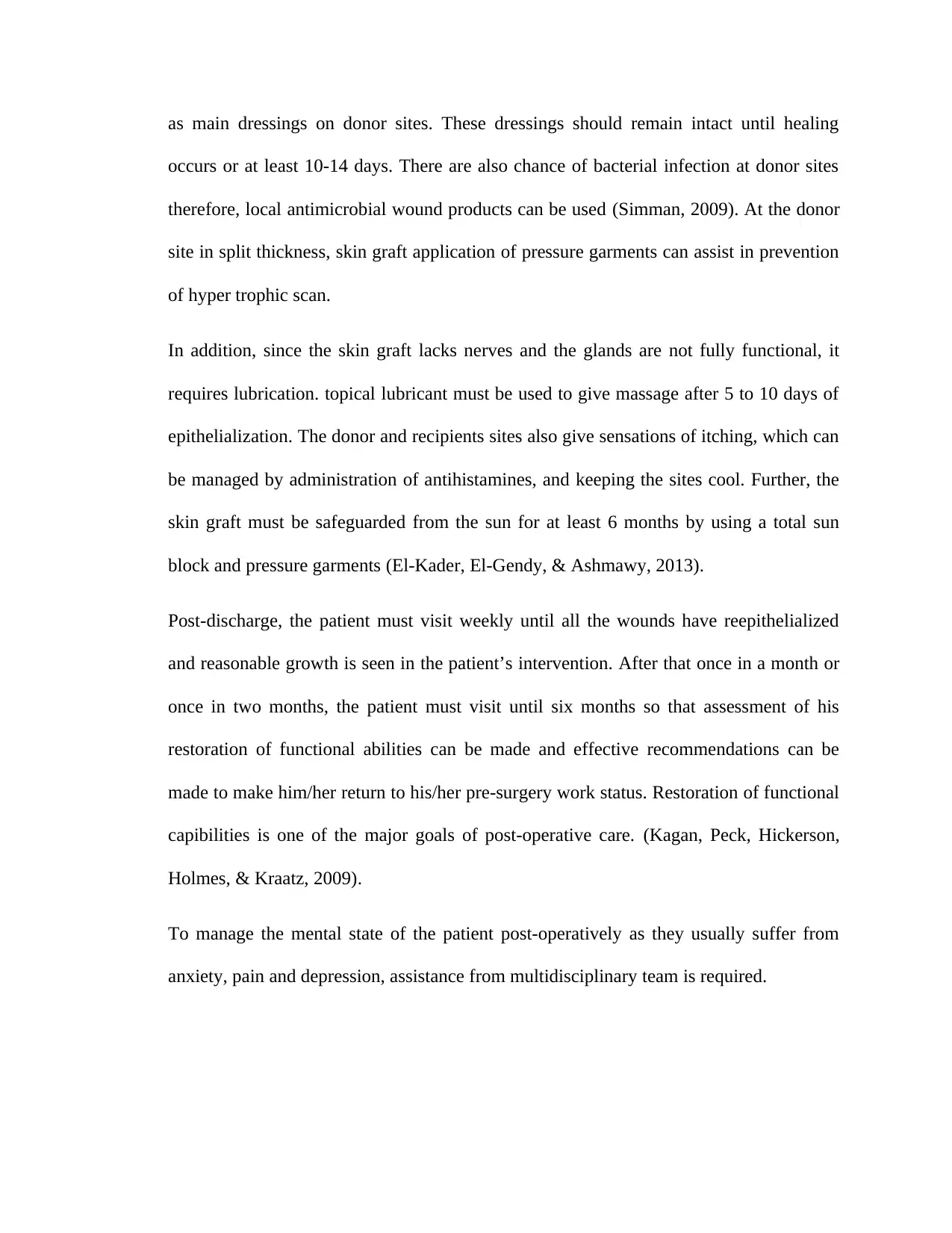
as main dressings on donor sites. These dressings should remain intact until healing
occurs or at least 10-14 days. There are also chance of bacterial infection at donor sites
therefore, local antimicrobial wound products can be used (Simman, 2009). At the donor
site in split thickness, skin graft application of pressure garments can assist in prevention
of hyper trophic scan.
In addition, since the skin graft lacks nerves and the glands are not fully functional, it
requires lubrication. topical lubricant must be used to give massage after 5 to 10 days of
epithelialization. The donor and recipients sites also give sensations of itching, which can
be managed by administration of antihistamines, and keeping the sites cool. Further, the
skin graft must be safeguarded from the sun for at least 6 months by using a total sun
block and pressure garments (El-Kader, El-Gendy, & Ashmawy, 2013).
Post-discharge, the patient must visit weekly until all the wounds have reepithelialized
and reasonable growth is seen in the patient’s intervention. After that once in a month or
once in two months, the patient must visit until six months so that assessment of his
restoration of functional abilities can be made and effective recommendations can be
made to make him/her return to his/her pre-surgery work status. Restoration of functional
capibilities is one of the major goals of post-operative care. (Kagan, Peck, Hickerson,
Holmes, & Kraatz, 2009).
To manage the mental state of the patient post-operatively as they usually suffer from
anxiety, pain and depression, assistance from multidisciplinary team is required.
occurs or at least 10-14 days. There are also chance of bacterial infection at donor sites
therefore, local antimicrobial wound products can be used (Simman, 2009). At the donor
site in split thickness, skin graft application of pressure garments can assist in prevention
of hyper trophic scan.
In addition, since the skin graft lacks nerves and the glands are not fully functional, it
requires lubrication. topical lubricant must be used to give massage after 5 to 10 days of
epithelialization. The donor and recipients sites also give sensations of itching, which can
be managed by administration of antihistamines, and keeping the sites cool. Further, the
skin graft must be safeguarded from the sun for at least 6 months by using a total sun
block and pressure garments (El-Kader, El-Gendy, & Ashmawy, 2013).
Post-discharge, the patient must visit weekly until all the wounds have reepithelialized
and reasonable growth is seen in the patient’s intervention. After that once in a month or
once in two months, the patient must visit until six months so that assessment of his
restoration of functional abilities can be made and effective recommendations can be
made to make him/her return to his/her pre-surgery work status. Restoration of functional
capibilities is one of the major goals of post-operative care. (Kagan, Peck, Hickerson,
Holmes, & Kraatz, 2009).
To manage the mental state of the patient post-operatively as they usually suffer from
anxiety, pain and depression, assistance from multidisciplinary team is required.
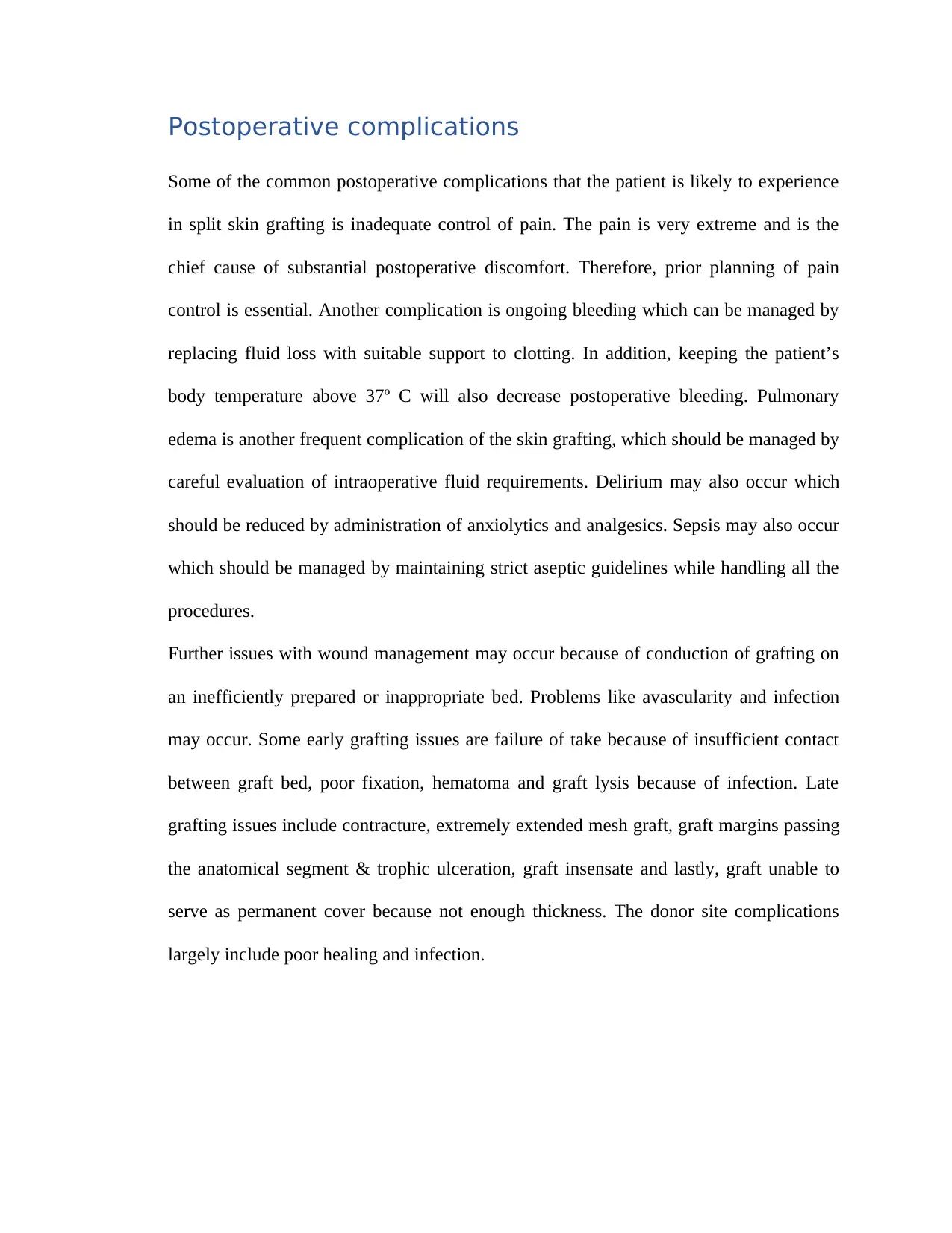
Postoperative complications
Some of the common postoperative complications that the patient is likely to experience
in split skin grafting is inadequate control of pain. The pain is very extreme and is the
chief cause of substantial postoperative discomfort. Therefore, prior planning of pain
control is essential. Another complication is ongoing bleeding which can be managed by
replacing fluid loss with suitable support to clotting. In addition, keeping the patient’s
body temperature above 37º C will also decrease postoperative bleeding. Pulmonary
edema is another frequent complication of the skin grafting, which should be managed by
careful evaluation of intraoperative fluid requirements. Delirium may also occur which
should be reduced by administration of anxiolytics and analgesics. Sepsis may also occur
which should be managed by maintaining strict aseptic guidelines while handling all the
procedures.
Further issues with wound management may occur because of conduction of grafting on
an inefficiently prepared or inappropriate bed. Problems like avascularity and infection
may occur. Some early grafting issues are failure of take because of insufficient contact
between graft bed, poor fixation, hematoma and graft lysis because of infection. Late
grafting issues include contracture, extremely extended mesh graft, graft margins passing
the anatomical segment & trophic ulceration, graft insensate and lastly, graft unable to
serve as permanent cover because not enough thickness. The donor site complications
largely include poor healing and infection.
Some of the common postoperative complications that the patient is likely to experience
in split skin grafting is inadequate control of pain. The pain is very extreme and is the
chief cause of substantial postoperative discomfort. Therefore, prior planning of pain
control is essential. Another complication is ongoing bleeding which can be managed by
replacing fluid loss with suitable support to clotting. In addition, keeping the patient’s
body temperature above 37º C will also decrease postoperative bleeding. Pulmonary
edema is another frequent complication of the skin grafting, which should be managed by
careful evaluation of intraoperative fluid requirements. Delirium may also occur which
should be reduced by administration of anxiolytics and analgesics. Sepsis may also occur
which should be managed by maintaining strict aseptic guidelines while handling all the
procedures.
Further issues with wound management may occur because of conduction of grafting on
an inefficiently prepared or inappropriate bed. Problems like avascularity and infection
may occur. Some early grafting issues are failure of take because of insufficient contact
between graft bed, poor fixation, hematoma and graft lysis because of infection. Late
grafting issues include contracture, extremely extended mesh graft, graft margins passing
the anatomical segment & trophic ulceration, graft insensate and lastly, graft unable to
serve as permanent cover because not enough thickness. The donor site complications
largely include poor healing and infection.
Paraphrase This Document
Need a fresh take? Get an instant paraphrase of this document with our AI Paraphraser
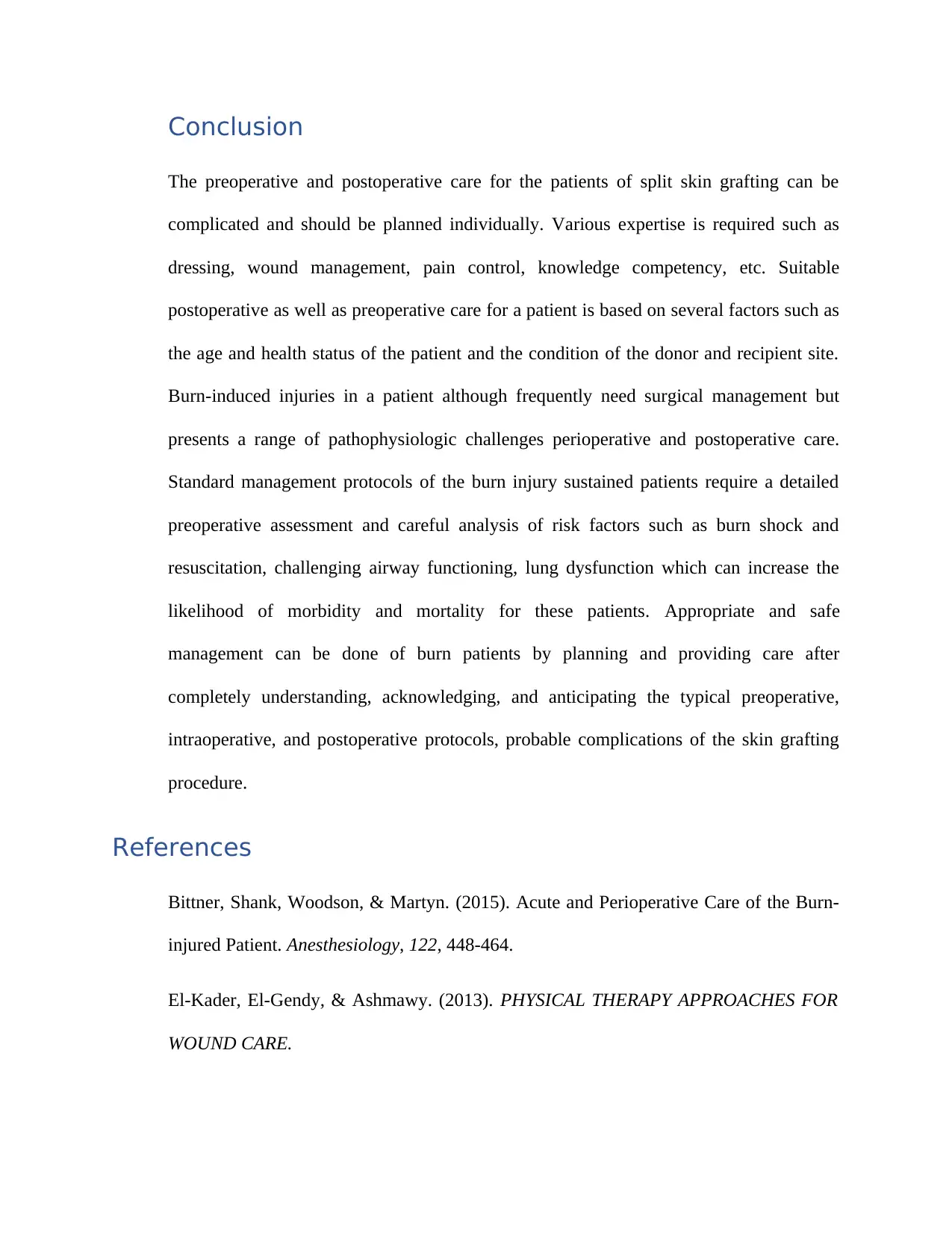
Conclusion
The preoperative and postoperative care for the patients of split skin grafting can be
complicated and should be planned individually. Various expertise is required such as
dressing, wound management, pain control, knowledge competency, etc. Suitable
postoperative as well as preoperative care for a patient is based on several factors such as
the age and health status of the patient and the condition of the donor and recipient site.
Burn-induced injuries in a patient although frequently need surgical management but
presents a range of pathophysiologic challenges perioperative and postoperative care.
Standard management protocols of the burn injury sustained patients require a detailed
preoperative assessment and careful analysis of risk factors such as burn shock and
resuscitation, challenging airway functioning, lung dysfunction which can increase the
likelihood of morbidity and mortality for these patients. Appropriate and safe
management can be done of burn patients by planning and providing care after
completely understanding, acknowledging, and anticipating the typical preoperative,
intraoperative, and postoperative protocols, probable complications of the skin grafting
procedure.
References
Bittner, Shank, Woodson, & Martyn. (2015). Acute and Perioperative Care of the Burn-
injured Patient. Anesthesiology, 122, 448-464.
El-Kader, El-Gendy, & Ashmawy. (2013). PHYSICAL THERAPY APPROACHES FOR
WOUND CARE.
The preoperative and postoperative care for the patients of split skin grafting can be
complicated and should be planned individually. Various expertise is required such as
dressing, wound management, pain control, knowledge competency, etc. Suitable
postoperative as well as preoperative care for a patient is based on several factors such as
the age and health status of the patient and the condition of the donor and recipient site.
Burn-induced injuries in a patient although frequently need surgical management but
presents a range of pathophysiologic challenges perioperative and postoperative care.
Standard management protocols of the burn injury sustained patients require a detailed
preoperative assessment and careful analysis of risk factors such as burn shock and
resuscitation, challenging airway functioning, lung dysfunction which can increase the
likelihood of morbidity and mortality for these patients. Appropriate and safe
management can be done of burn patients by planning and providing care after
completely understanding, acknowledging, and anticipating the typical preoperative,
intraoperative, and postoperative protocols, probable complications of the skin grafting
procedure.
References
Bittner, Shank, Woodson, & Martyn. (2015). Acute and Perioperative Care of the Burn-
injured Patient. Anesthesiology, 122, 448-464.
El-Kader, El-Gendy, & Ashmawy. (2013). PHYSICAL THERAPY APPROACHES FOR
WOUND CARE.
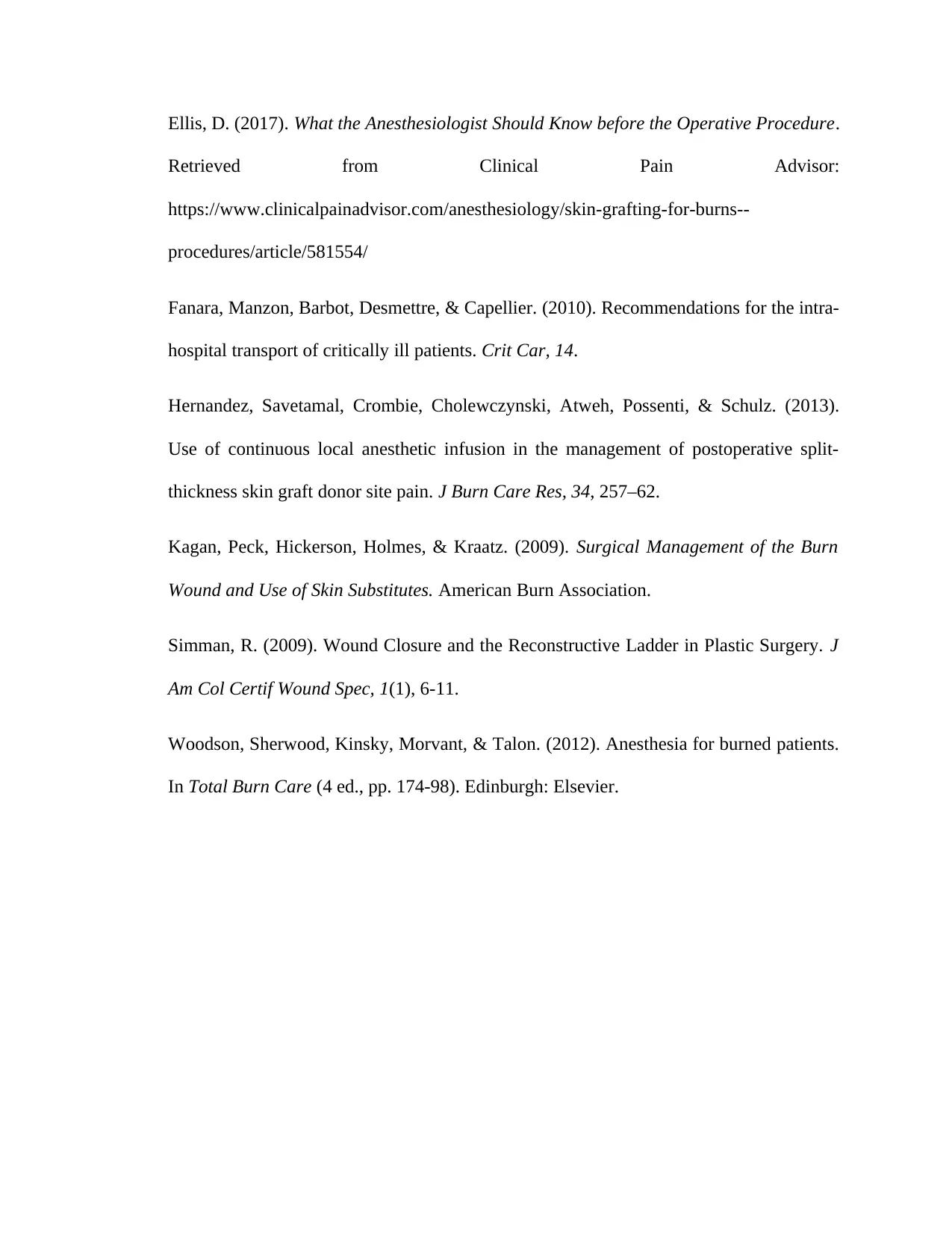
Ellis, D. (2017). What the Anesthesiologist Should Know before the Operative Procedure.
Retrieved from Clinical Pain Advisor:
https://www.clinicalpainadvisor.com/anesthesiology/skin-grafting-for-burns--
procedures/article/581554/
Fanara, Manzon, Barbot, Desmettre, & Capellier. (2010). Recommendations for the intra-
hospital transport of critically ill patients. Crit Car, 14.
Hernandez, Savetamal, Crombie, Cholewczynski, Atweh, Possenti, & Schulz. (2013).
Use of continuous local anesthetic infusion in the management of postoperative split-
thickness skin graft donor site pain. J Burn Care Res, 34, 257–62.
Kagan, Peck, Hickerson, Holmes, & Kraatz. (2009). Surgical Management of the Burn
Wound and Use of Skin Substitutes. American Burn Association.
Simman, R. (2009). Wound Closure and the Reconstructive Ladder in Plastic Surgery. J
Am Col Certif Wound Spec, 1(1), 6-11.
Woodson, Sherwood, Kinsky, Morvant, & Talon. (2012). Anesthesia for burned patients.
In Total Burn Care (4 ed., pp. 174-98). Edinburgh: Elsevier.
Retrieved from Clinical Pain Advisor:
https://www.clinicalpainadvisor.com/anesthesiology/skin-grafting-for-burns--
procedures/article/581554/
Fanara, Manzon, Barbot, Desmettre, & Capellier. (2010). Recommendations for the intra-
hospital transport of critically ill patients. Crit Car, 14.
Hernandez, Savetamal, Crombie, Cholewczynski, Atweh, Possenti, & Schulz. (2013).
Use of continuous local anesthetic infusion in the management of postoperative split-
thickness skin graft donor site pain. J Burn Care Res, 34, 257–62.
Kagan, Peck, Hickerson, Holmes, & Kraatz. (2009). Surgical Management of the Burn
Wound and Use of Skin Substitutes. American Burn Association.
Simman, R. (2009). Wound Closure and the Reconstructive Ladder in Plastic Surgery. J
Am Col Certif Wound Spec, 1(1), 6-11.
Woodson, Sherwood, Kinsky, Morvant, & Talon. (2012). Anesthesia for burned patients.
In Total Burn Care (4 ed., pp. 174-98). Edinburgh: Elsevier.
1 out of 9
Related Documents
Your All-in-One AI-Powered Toolkit for Academic Success.
+13062052269
info@desklib.com
Available 24*7 on WhatsApp / Email
![[object Object]](/_next/static/media/star-bottom.7253800d.svg)
Unlock your academic potential
© 2024 | Zucol Services PVT LTD | All rights reserved.



